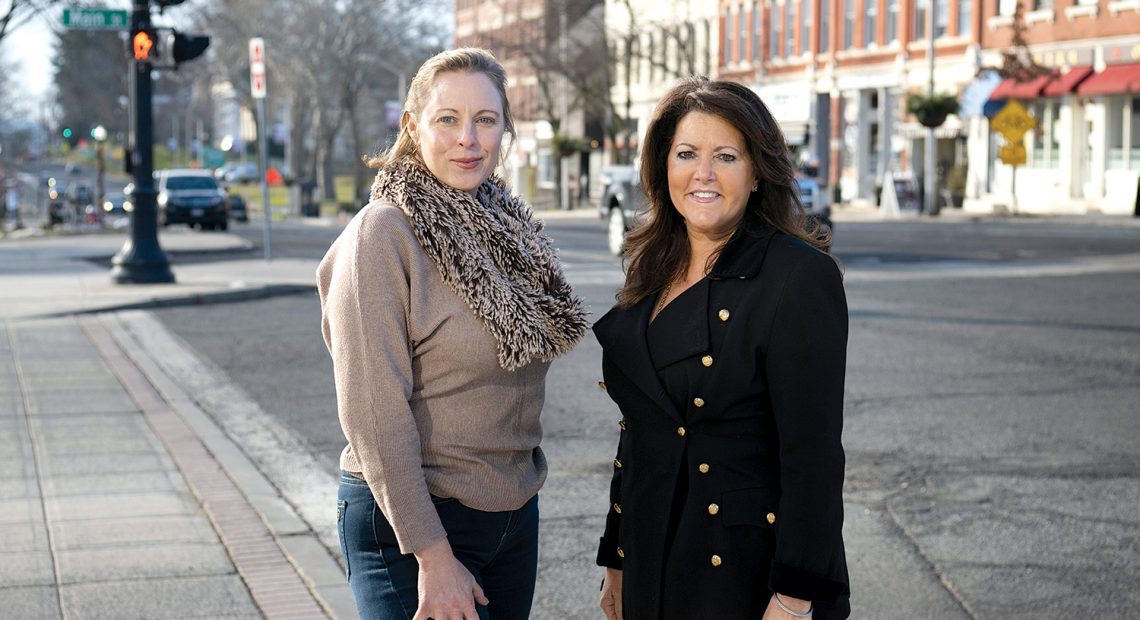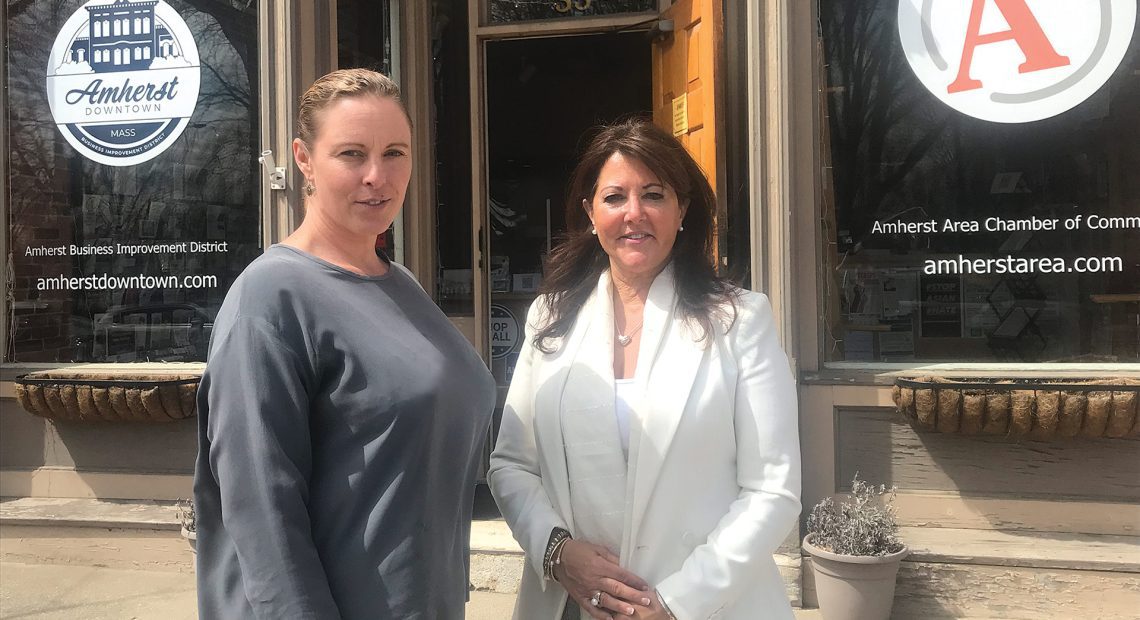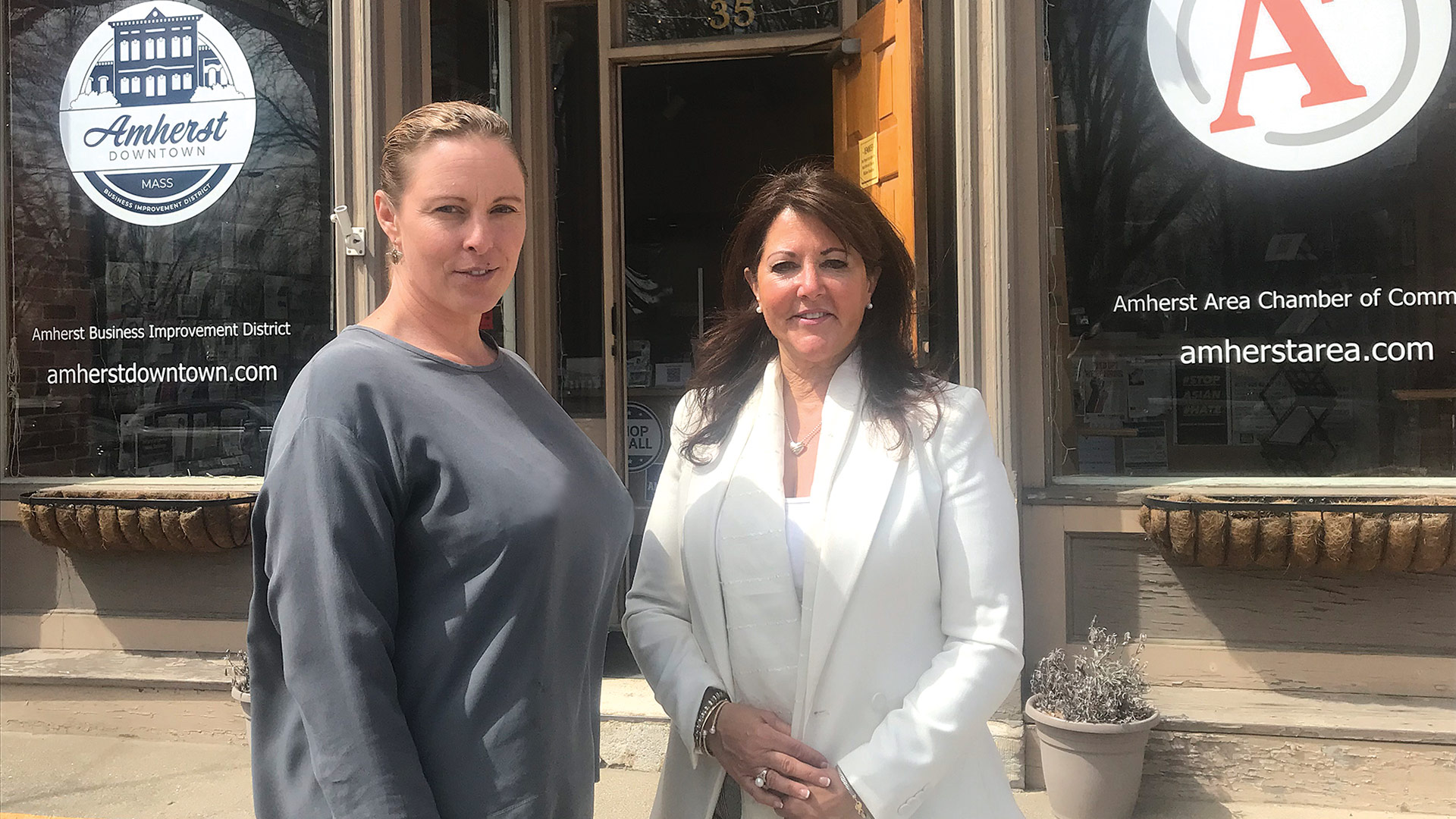These Amherst Leaders Work in Partnership to Build a Stronger Community
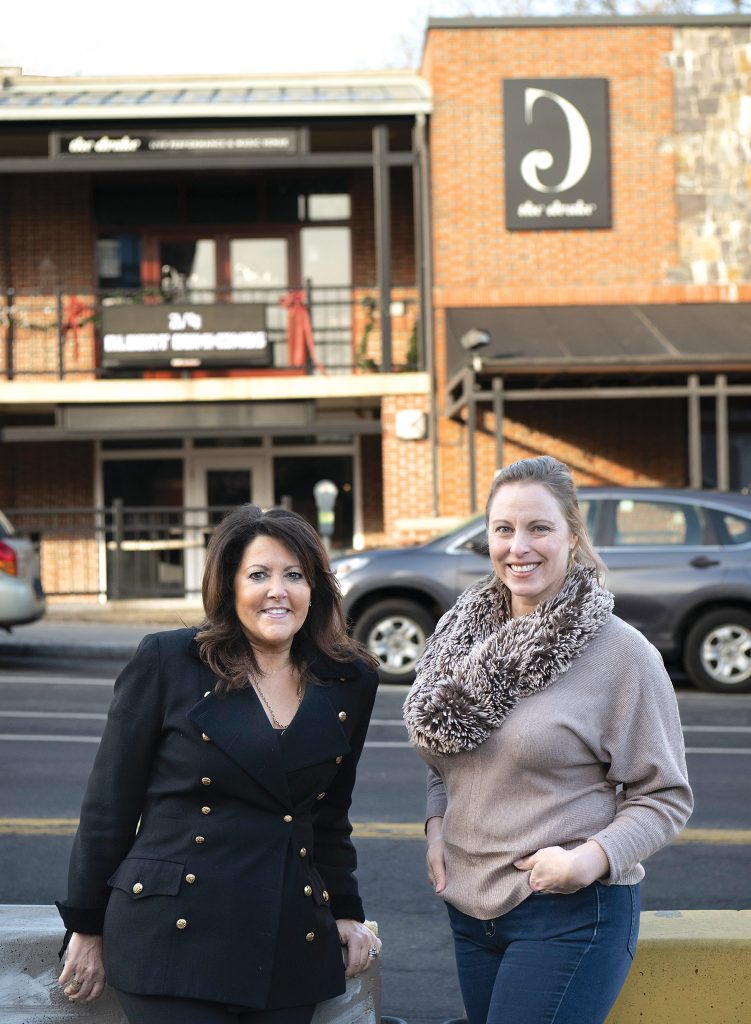
Leah Martin Photography
March 13, 2020.
Both Claudia Pazmany and Gabrielle Gould remember that date, and they say they’re not likely to ever forget it.
It was the day when Gould, executive director of the Amherst Business Improvement District (BID) received word that the Downtown Amherst Foundation she created had officially received its 501(c)(3) status. But that long-awaited good news was rendered all but moot by what else was happening that day — the shutting down of the Commonwealth by Gov. Charlie Baker as the COVID-19 pandemic reached the Bay State and the first deaths were being reported.
“I was thinking, ‘I did all this work to create this foundation that was going to do all these amazing things, and now we’re in lockdown, and we’re not going to be doing anything,’” Gould recalled.
She and Pazmany, executive director of the Amherst Area Chamber of Commerce, who share space in the chamber offices on South Pleasant Street in the heart of the community’s downtown, remember walking out the door together that afternoon, turning off the lights, and setting the heat at 56 degrees as they went.
What they were walking into … well, they had no idea, really.
Turns out, they were walking into what would become a deep (or deeper, to be more precise) and quite extraordinary partnership, through which they would help lead a community that was devasted by the pandemic perhaps more than any other in this region, and maybe the entire state, out of that darkness.
A partnership that makes them true Difference Makers in the Greater Amherst area.
Working separately on some initiatives, but hand-in-hand in most all others, they have helped change the landscape in Amherst and its downtown in all kinds of ways, as we’ll see. But they are also being honored for ensuring that the landscape didn’t change more than it did. Indeed, it is through their efforts that many businesses were able to survive that storm.
“It was a devastating time, but from that, we forged this great partnership,” Pazmany said of the early days of the pandemic. “And we put our collective talents and resources together to put information out there and help people and businesses in need. It was remarkable to see how people came together in that time of crisis.”
By Gould’s count, Amherst “lost more than 45,000 people overnight” that fateful day in March 2020. That number includes students at the three colleges that call the community home — UMass Amherst, Hampshire College, and Amherst College — but also thousands of people who came to work at those institutions and other businesses in town. It also includes tourists who wouldn’t be coming, parents of students and alumni who wouldn’t be attending sporting events or anything else, visiting lecturers who wouldn’t be on campus, performing artists who wouldn’t be coming … you get the idea.
“It was a devastating time, but from that, we forged this great partnership. And we put our collective talents and resources together to put information out there and help people and businesses in need. It was remarkable to see how people came together in that time of crisis.”
In the wake of this exodus, businesses were left dazed and looking for some kind of answers — and any kind of help. Pazmany and Gould helped provide both, with everything from PPE (which they delivered themselves) to virtual ‘tip jars’ to help those out of work; from small-business microgrants to grant-application coaching. They bought hundreds of thousands of dollars worth of meals from restaurants and gift cards and other items from businesses to both help them survive and assist families and individuals in need.
With this assistance, and their own sheer will to survive, many businesses have made it through the pandemic and to the other side.
But this story, this partnership, is not just about COVID and helping businesses ride out that storm. Indeed, it’s an ongoing story of bringing new businesses and new vibrancy to downtown Amherst and beyond. Businesses like the live-performance venue known as the Drake, an initiative of the Downtown Amherst Foundation, which, in less than a year, has brought roughly 1,000 performers and more than 15,000 patrons to the community.

Claudia Pazmany arranges meals that were bought from Amherst-area restaurants and given to those in need as part of the Dinner Delights program staged during the height of the pandemic.
This informal partnership’s philosophy is summed up in a branded campaign launched in 2021 and funded by a Massachusetts Office of Travel and Tourism grant, called, appropriately, “What’s Next? Greater Amherst.” It includes a YouTube video and a website — www.greateramherst.com — that highlights the natural beaty, global cuisine, and arts and culture in the community and helps people who are planning a visit.
“Without our collaborative help and willingness to sit in these offices at 7 o’clock at night with business owners with masks on and help them upload their documents and write grants, I think you would have seen a lot more businesses throughout Amherst close.”
Overall, these partners continue to work to make Greater Amherst both a destination and a place to put down business roots. Thanks to them, what’s next is more creative programing, more opportunities for growth, and more vibrancy.
And that makes them true Difference Makers.
The Power of Two
Returning to the dark days of the start of the pandemic — and they were dark … the lights literally went out in downtown Amherst — isn’t exactly easy for Gould and Pazmany.
These were extraordinary and, in many ways, desperate times when business just stopped. There was a great deal of uncertainty about what would happen, they recalled, and for several weeks after the state was shut down, businesses suffered mightily.
But as they looked back, these two partners said that was also a time of what could, in some ways, be called triumph, when people, and a community, reached down deep to find ways to support one another and help them through that darkness.

Stamell Stringed Instruments was one of dozens of Amherst-area businesses to receive gifts of PPE — free safety posters, gloves, sanitizer, and more — as a part of the #IAMherst campaign, through monies raised through the Downtown Amherst Foundation.
Before we elaborate on that, let’s set the stage by talking about the two organizations and their missions.
Like several other communities in the area, Amherst has both a chamber and a business-improvement district. The former, as most know, exists to promote and support businesses, and it does this through everything from advocacy (at the local, state, regional, and national levels) to education and providing forums for businesses to gather, network, learn, and perhaps do business with one another.
The BID, meanwhile, is charged with everything from cleaning up downtown and watering the plants growing from hanging baskets to handling holiday lighting displays and marketing the community through initiatives such as Destination Amherst.
But it was during the pandemic that the two organizations really came together, pooled their resources, and put their various skills sets to work.
Pazmany and Gould were working remotely at the time — the chamber office, like most businesses, was closed — but they were together often, working long days (and a great many nights) to help businesses. Here are just some examples of what they were able to do together:
• Raise close to a half-million dollars and distribute what became known as Relief and Resiliency microgrants to 67 small businesses throughout Amherst, the lion’s share of the money coming from residents, with donations from $25 to $50,000;
• Buy bulk PPE (masks, gloves, hand sanitizer, and more) at a time when it was difficult for businesses to attain it, and deliver it to businesses;
• Create a virtual tip jar so residents could support the many who were out of work — rom artists to hairdressers to bartenders;
• Launch the Dinner Delights program, through which the two agencies raised more than $100,000 and used those finds to purchase dinners and lunches from area restaurants to keep them in business, and hand out the meals to families in need;
• Provide those same families with gift bags filled with toys, puzzles, and gift cards purchased from a wide array of businesses — from hair salons to convenience stores — to help those small ventures;
• Continue some time-honored traditions, albeit virtually, such as the lighting of the Merry Maple, a maple tree on the North Common, during the holidays;
• Encourage takeout business at a time when the restaurants needed it and when there was some resistance to such efforts from the colleges and elsewhere in the community;
• Register close to 200 individuals within the business community, including many for whom English is their second language, for vaccination; and
• Provide assistance with state and federal grants. Together, by Gould’s estimates, they were able to help businesses secure more than $2.1 million in state and federal grants by sitting down with them and helping them write grants.
“Without our collaborative help and willingness to sit in these offices at 7 o’clock at night with business owners with masks on and help them upload their documents and write grants, I think you would have seen a lot more businesses throughout Amherst close,” Gould said. “While many people were at home staying safe, which they should have been doing, Claudia and I came to work every day; we showed up, we went out in public, we hand-delivered grants.”
Pazmany agreed, noting that both agencies looked beyond their respective missions and beyond the downtown itself to help a decimated community at a time of dire need.
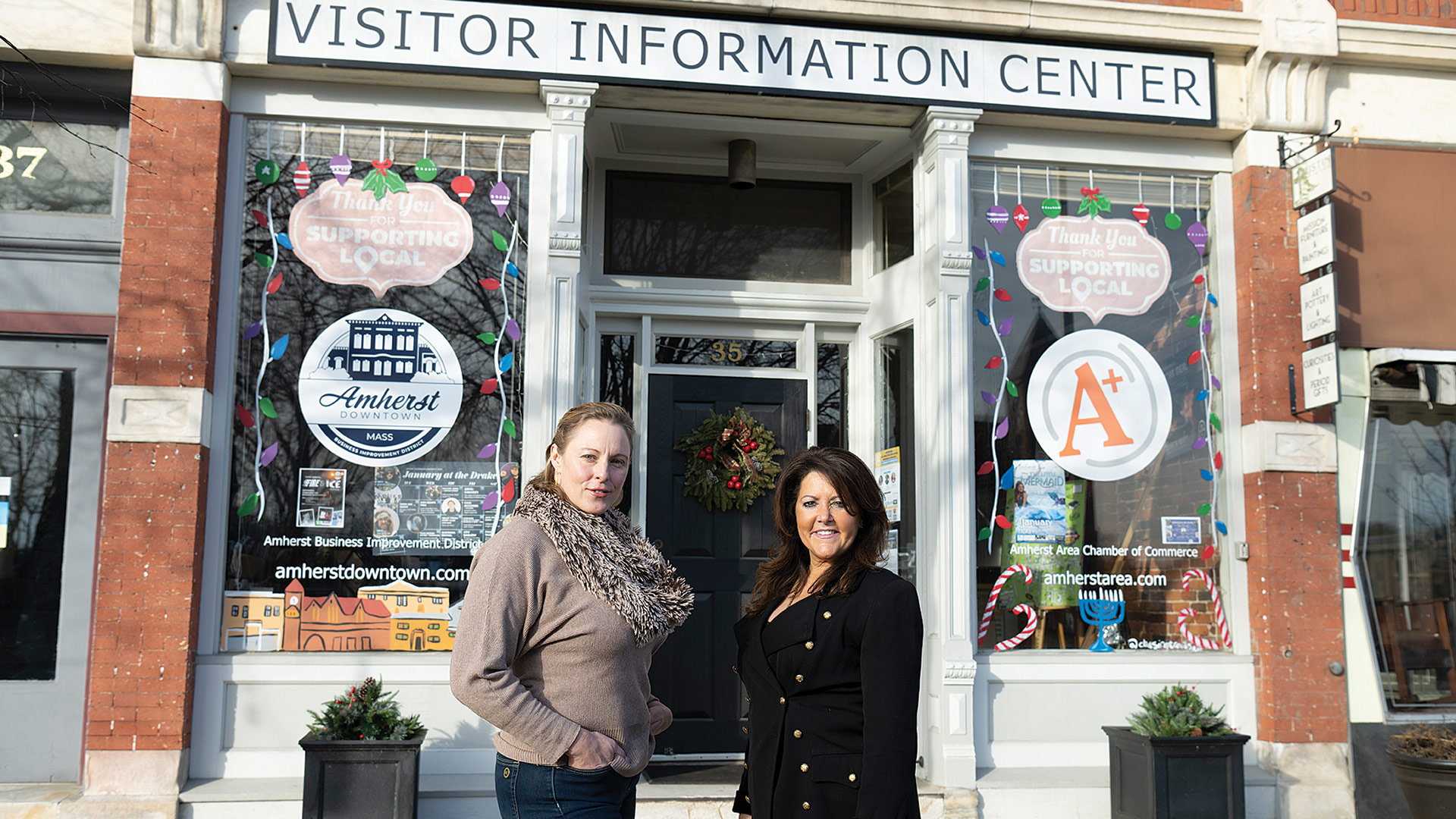
Gabrielle Gould and Claudia Pazmany have worked tirelessly to promote Amherst and the surrounding area as a destination.
Leah Martin Photography
“We all had PPE in our cars for two months — and we delivered it door-to-door,” she recalled. “I looked beyond my membership, and she looked beyond the downtown, and together we were able to look at the collective impact of our shared work around the entire town of Amherst.”
As significant as the work during the pandemic was, this partnership, as noted earlier, is about much more than those efforts.
Indeed, it’s about ongoing work to put Greater Amherst on the map and make it even more of a destination for visitors and home for businesses of all kinds. Here again, the agencies have worked independently of one another, but mostly in concert, to get a number of things done.
Things like the Drake, a venue that has brought people from across New England and beyond to downtown Amherst and provides ample proof of the power of the arts as an economic-development engine.
“I truly believe that arts and culture in a community builds economic development,” Pazmany told BusinessWest. “And it builds reasons for people to come to your community and be part of your community, to want to live here and do business here.”
Bottom Line
Looking ahead, Gould said the BID is working on several initiatives, including a spring block party in the downtown with a focus and arts and culture, a summer music series on the Commons, revitalization of the North Common, and creation of more anchors in the downtown.
As for the chamber, Pazmany said a great amount of momentum was generated in 2022 as a number of popular events, from After 5 gatherings to the annual fundraiser Margarita Madness, returned to the calendar. The goal for 2023 is to build on this momentum, generate new membership, and continue to support businesses across Greater Amherst.
“I truly believe that arts and culture in a community builds economic development. And it builds reasons for people to come to your community and be part of your community, to want to live here and do business here.”
“For us, it’s getting back to what we normally do as a chamber,” she explained. “We’re focusing on getting all our events back, making them better than ever, and connecting businesses.”
Gould told BusinessWest that she’s learned that Amherst’s response to the pandemic — the various programs created and carried out by the chamber and the BID — has been hailed as one of the best in the Commonwealth and a model of cooperation and innovation for other communities to follow.
Likewise, the Drake project has become a model itself — of how an organization like the BID can take a concept, raise the money needed, and make it a reality, all in roughly a year’s time.
Pazmany and Gould weren’t thinking about creating models or case studies when they undertook these programs. They were thinking about their community, and how to make it stronger, more resilient, and more of a destination. The fact that they have become models for other towns is testimony to the high levels of imagination, determination, and perseverance these two have brought to their ongoing work.
And that explains why they are Difference Makers.



